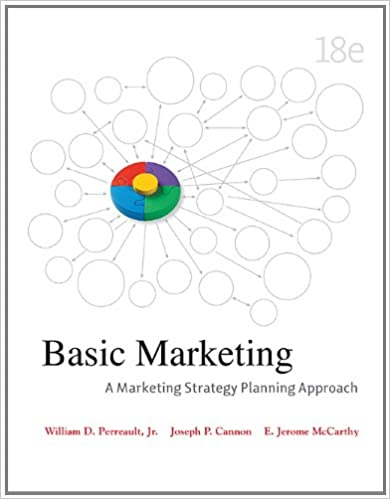
BASIC MARKETING 18th Edition by Jerome McCarthy William Perreault, Joseph Cannon
Edition 18ISBN: 978-0077577193
BASIC MARKETING 18th Edition by Jerome McCarthy William Perreault, Joseph Cannon
Edition 18ISBN: 978-0077577193 Exercise 1
TOTAL DISTRIBUTION COST
Proto Company has been producing various items made of plastic. It recently added a line of plain plastic cards that other firms (such as banks and retail stores) will imprint to produce credit cards. Proto offers its customers the plastic cards in different colors, but they all sell for $40 per box of 1,000. Tom Phillips, Proto's product manager for this line, is considering two possible physical distribution systems. He estimates that if Proto uses airfreight, transportation costs will be $7.50 a box, and its cost of carrying inventory will be 5 percent of total annual sales dollars. Alternatively, Proto could ship by rail for $2 a box. But rail transport will require renting space at four regional warehouses-at $26,000 a year each. Inventory carrying cost with this system will be 10 percent of total annual sales dollars. Phillips prepared a spreadsheet to compare the cost of the two alternative physical distribution systems.
a. If Proto Company expects to sell 20,000 boxes a year, what are the total physical distribution costs for each of the systems?
b. If Phillips can negotiate cheaper warehouse space for the rail option so that each warehouse costs only $20,000 per year, which physical distribution system has the lowest overall cost?
c. Proto's finance manager predicts that interest rates are likely to be lower during the next marketing plan year and suggests that Tom Phillips use inventory carrying costs of 4 percent for airfreight and 7.5 percent for railroads (with warehouse cost at $20,000 each). If interest rates are in fact lower, which alternative would you suggest? Why?
Proto Company has been producing various items made of plastic. It recently added a line of plain plastic cards that other firms (such as banks and retail stores) will imprint to produce credit cards. Proto offers its customers the plastic cards in different colors, but they all sell for $40 per box of 1,000. Tom Phillips, Proto's product manager for this line, is considering two possible physical distribution systems. He estimates that if Proto uses airfreight, transportation costs will be $7.50 a box, and its cost of carrying inventory will be 5 percent of total annual sales dollars. Alternatively, Proto could ship by rail for $2 a box. But rail transport will require renting space at four regional warehouses-at $26,000 a year each. Inventory carrying cost with this system will be 10 percent of total annual sales dollars. Phillips prepared a spreadsheet to compare the cost of the two alternative physical distribution systems.
a. If Proto Company expects to sell 20,000 boxes a year, what are the total physical distribution costs for each of the systems?
b. If Phillips can negotiate cheaper warehouse space for the rail option so that each warehouse costs only $20,000 per year, which physical distribution system has the lowest overall cost?
c. Proto's finance manager predicts that interest rates are likely to be lower during the next marketing plan year and suggests that Tom Phillips use inventory carrying costs of 4 percent for airfreight and 7.5 percent for railroads (with warehouse cost at $20,000 each). If interest rates are in fact lower, which alternative would you suggest? Why?
Explanation
Distribution cost of the company is the ...
BASIC MARKETING 18th Edition by Jerome McCarthy William Perreault, Joseph Cannon
Why don’t you like this exercise?
Other Minimum 8 character and maximum 255 character
Character 255


